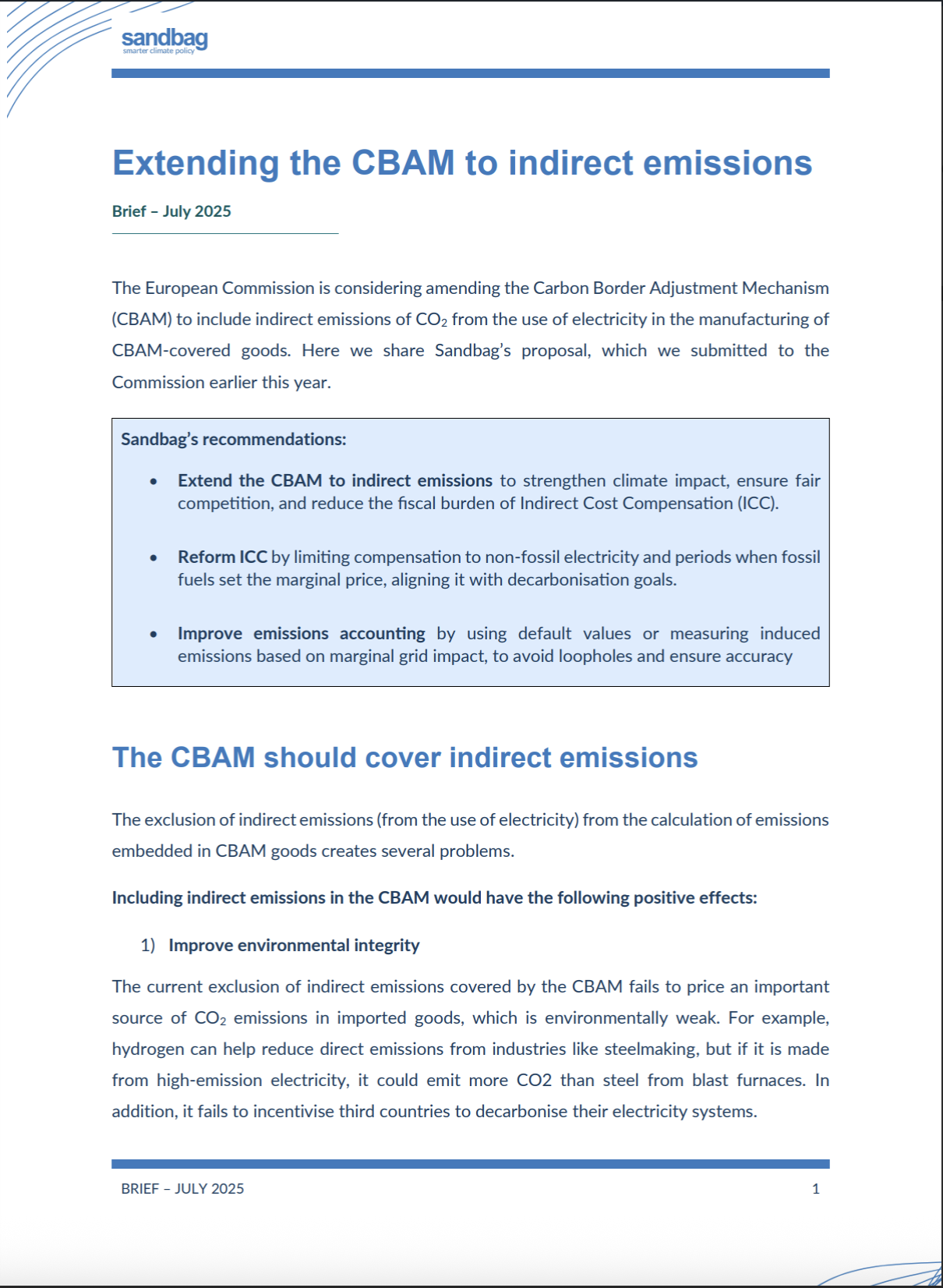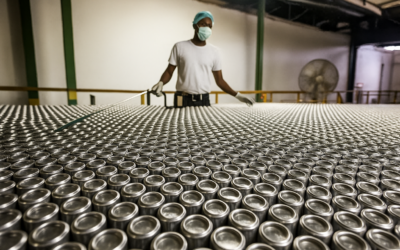The European Commission is considering amending the Carbon Border Adjustment Mechanism (CBAM) to include indirect emissions of CO2 from the use of electricity in the manufacturing of CBAM-covered goods.
Here we share Sandbag’s proposal, which we submitted to the Commission earlier this year.

Sandbag’s recommendations
• Extend the CBAM to indirect emissions to strengthen climate impact, ensure fair competition, and reduce the fiscal burden of Indirect Cost Compensation (ICC).
• Reform ICC by limiting compensation to non-fossil electricity and periods when fossil fuels set the marginal price, aligning it with decarbonisation goals.
• Improve emissions accounting by using default values or measuring induced emissions based on marginal grid impact, to avoid loopholes and ensure accuracy
The CBAM should cover indirect emissions
The exclusion of indirect emissions (from the use of electricity) from the calculation of emissions embedded in CBAM goods creates several problems.
Including indirect emissions in the CBAM would have the following positive effects:
1) Improve environmental integrity
The current exclusion of indirect emissions covered by the CBAM fails to price an important source of CO2 emissions in imported goods, which is environmentally weak. For example, hydrogen can help reduce direct emissions from industries like steelmaking, but if it is made from high-emission electricity, it could emit more CO2 than steel from blast furnaces. In addition, it fails to incentivise third countries to decarbonise their electricity systems.
2) Avoid competitive disadvantages
Electricity prices in the EU reflect the cost of carbon, so EU industries indirectly pay for carbon through their electricity bills. However, many of them don’t receive any compensation for those costs, because only 14 Member States participate in the Indirect Cost Compensation (ICC) scheme. For installations located in the remaining 16 countries, the exclusion of indirect emissions from the CBAM therefore creates unfair competition with imports from overseas.
3) Reduce fiscal burden
The ICC scheme cost €600m to France and €1.6bn to Germany in 2023. This bill is only going to rise with greater electrification and rising carbon prices. Including indirect emissions in the CBAM would mean Member States could receive revenues under the CBAM.
4) Future-proof the CBAM
As electrification accelerates and carbon prices continue to rise, indirect emissions will account for a growing share of industrial emissions. EU producers will face more indirect costs due to electrification and higher carbon prices, while importers will use more electricity to exploit the lack of coverage of indirect emissions in the CBAM. Indirect emissions should therefore be covered by the CBAM as soon as possible.
Reform indirect cost compensation
However, integrating indirect emissions into the CBAM cannot be done with ICC in place in its current form. Since the indirect costs borne by EU electricity consumers are not proportional to the carbon content of electricity, abolishing ICC altogether would not level the playing field between the EU and third countries. Instead, we propose to reform ICC. Currently, all electricity consumed by the industry is eligible for compensation, including fossil electricity, which provides no incentive for consumers to source low-carbon electricity.
Industrial installations using 24-hour grid electricity are rewarded all the same. Instead, ICC should only be given to the non-fossil share of electricity consumed. In addition, it should be limited to periods when fossil electricity sets the marginal price of the bidding zone of the installation. These changes would reward the use of low-carbon (including renewable) electricity by industrial installations. In addition, it would be compatible with an extension of the CBAM to indirect emissions, because the scope of ICC (fossil-free electricity) and the CBAM (fossil-based electricity) would be different.
Count induced emissions in the CBAM
With the current method of reporting under the CBAM, emissions attributed to use of electricity in the manufacturing of a goods are either based on the country’s grid emission factor or, if the manufacturing plant has a direct link or a power purchase agreement (PPA) with a renewable energy source (RES), zero. It is therefore possible for third country exporters to reduce their CBAM fees by signing PPAs or connecting their factories to existing RES, without benefitting the climate.
This could be avoided if default values was the only possible option. Alternatively, an even better way of calculating indirect emissions would be taking into account the impact of the manufacturing plant on the (marginal) power sector emission of the exporting country, rather than the emissions of the power plant specifically used for the goods. If the plant only functions at times of abundant low-carbon electricity in the grid, then the plant creates no extra need for fossil electricity generation in the country and its electricity should be considered as carbon free, regardless of being connected to a RES (directly or through a PPA).
In contrast, if the plant functions at times of high electricity demand, it will create extra demand for fossil electricity generation even if it uses a dedicated RES, because that RES ends up not meeting the broader demand. In this case, the plant creates induced fossil powergeneration and induced CO2 emissions (see our recent report Getting Electrification Right: The broader challenge of induced emissions).
A better calculation method would estimate the emissions induced by the goods’ manufacturing plant, which should use the emission intensity of marginal power plants at the time when the goods’ manufacturing plant operates. This would only make sense for plants that can run at specific times (i.e. not 24 hours) and can safely report the timing of their operations, whereas in other cases default values are more appropriate.
Related publications
Chemicals in the CBAM: Time to step up
Sandbag’s latest brief explains why the EU CBAM must be expanded to cover key chemical value chains. With chemicals and refinery products responsible for 30% of industry emissions, phased inclusion is critical to prevent carbon leakage and phase out free allowances.
The EU CBAM: a two-way street between the EU and Africa
Sandbag’s newly released CBAM Simulator allowed us to explore how the EU’s Carbon Border Adjustment Mechanism (CBAM) could impact African exporters — and how cleaner production and carbon pricing could turn a cost into a competitive edge.
CBAM impact on US trade: an analysis
Sandbag’s September 2025 research note explores the impact of the EU’s CBAM on US exports. It finds that even with expanded scope, the financial impact remains marginal — and US carbon pricing could turn net costs negative.



